Meteors
Meteor showers occur annually or at regular intervals as the Earth passes through the trail of dusty debris left by a comet.

Meteor showers are usually named after a star or constellation that is close to where the meteors appear in the sky. Viewing a meteor shower is most satisfying in a dark sky location, as far from urban light pollution as possible. Unfortunately, Griffith Observatory and big cities are not good viewing locations for meteor showers. The Observatory offers assessments of annual meteor shower viewing, which often depend on the phase of the Moon. The NASA Meteor page has more information.
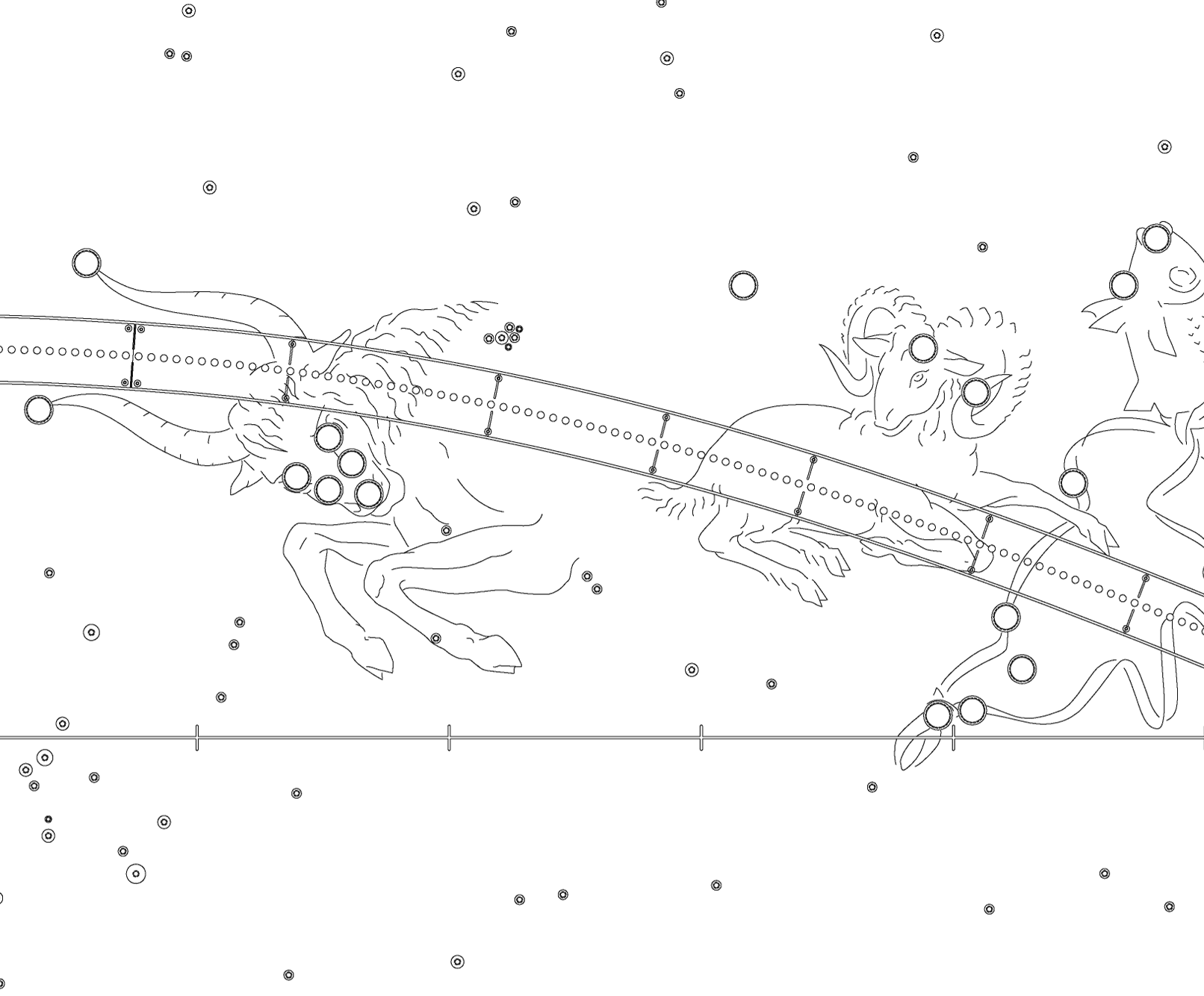
The information below for 2024 and 2025 is intended as an aid to meteor watchers in southern California. Meteors are best observed from dark wilderness locations, far from city lights. The glow from light-pollution in most cities and suburbs allows only a few bright meteors to be seen. The brightness of the Moon must also be taken into account, as it can have a large effect on the number of meteors that will be visible. Some meteor showers have a very brief peak, lasting only a few hours, and sometimes the peak occurs at a time when the shower is not visible from southern California. These factors have been taken into account in the listings below, which assess the viewing prospects. The estimates of numbers of meteors per hour are based on viewing from a dark sky location in southern California.
The best way to watch a meteor shower is to travel to a wilderness area or campground that has a dark sky. It’s best to choose a night when the Moon is not visible during the shower. Most meteor showers are strongest after midnight and until dawn. Dress warmly and lie back on a deck chair or lounge, so you are looking up at the sky. Don’t look at bright lights like flashlights or cell phone displays which can desensitize your eyes for ten minutes or more.
Because Griffith Observatory is surrounded by urban light glow, Griffith Park and the Observatory are not recommended as meteor shower observing locations, and are not open after normal closing time (10:00 p.m.).
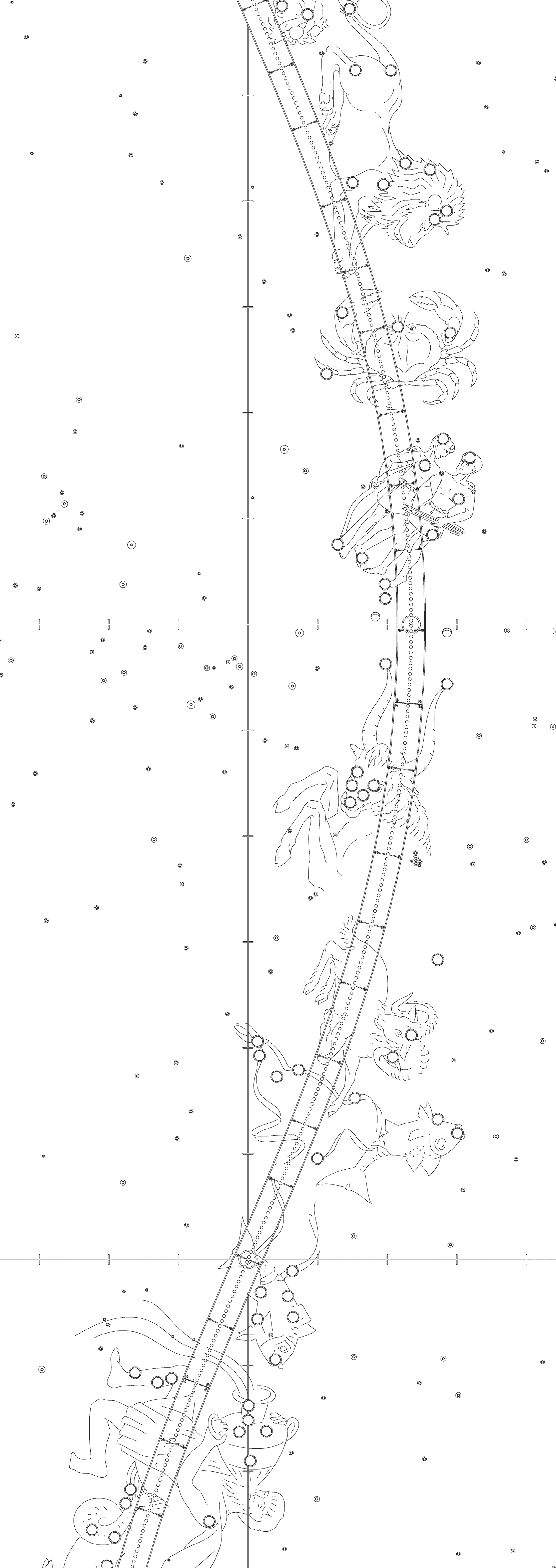
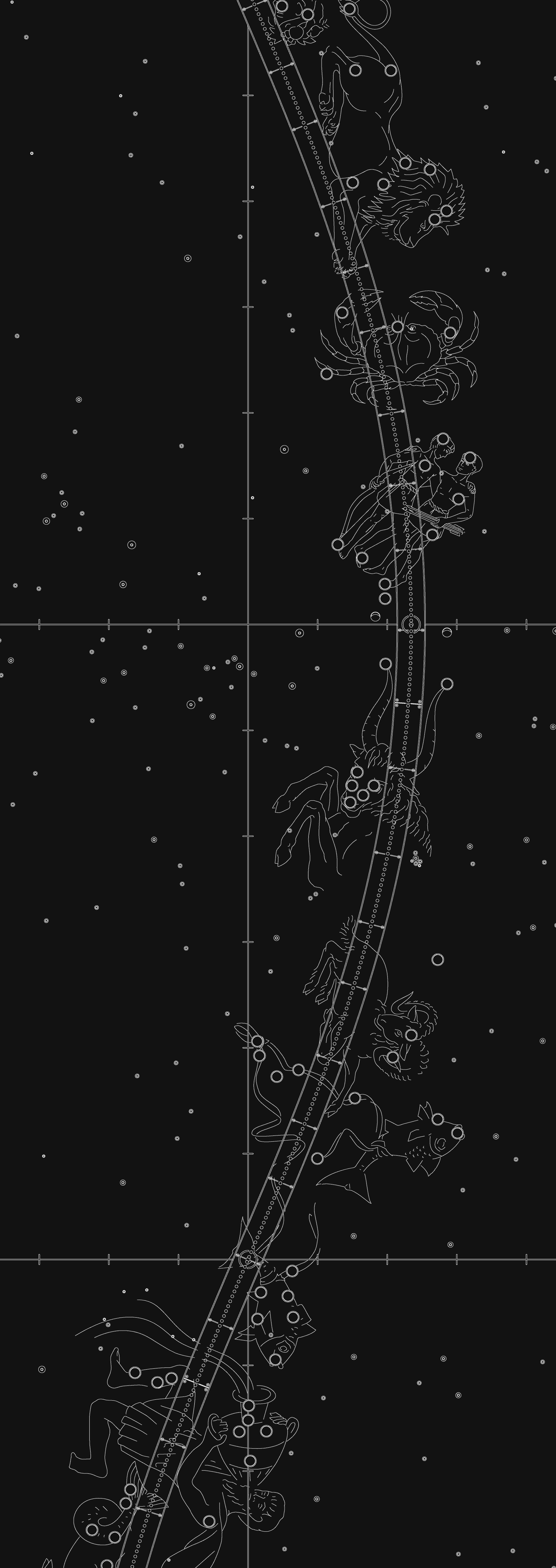
Meteor Showers for 2025
Quadrantids
 Active: December 28 – January 12
Active: December 28 – January 12
Peak Night: January 2nd/3rd
When can it be observed?: From Midnight (12:00 a.m.) – 5:30 a.m.
Expected dark sky rate: 80 meteors per hour.
Moon phase: 10% waxing crescent ( Fireballs have been observed even a few days after peak.)
GOOD VIEWING CONDITIONS
Quadrantids likely are particles from the extinct comet 2003 EH1. They hit our atmosphere with a velocity of 25 miles (41 kilometers) per second. The meteors stream from a radiant located in the northern part of Boötes the Herdsman, between the main figure of Boötes and the handle of the Big Dipper, the site of an obsolete constellation, Quadrans Muralis the Mural Quadrant.
Lyrids
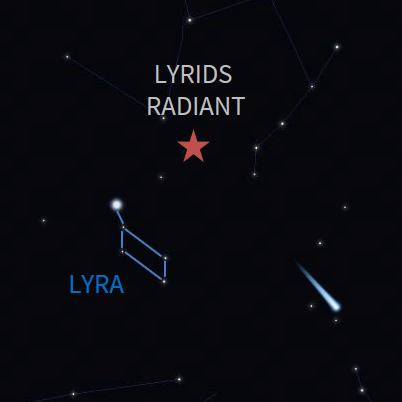 Active: April 14 – April 30
Active: April 14 – April 30
Peak Night: April 21st/22nd
When can it be observed?: From 10:00 p.m. – 4:30 a.m.
Expected dark sky rate: 18 meteors per hour.
Moon phase: 42% waning crescent ( The waning crescent moon will rise just after 3am on the April 22. This allows the observer about six hours of viewing time near the peak.)
GOOD VIEWING CONDITIONS
Lyrid meteors are particles shed by the comet C/1861 G (Thatcher). They hit our atmosphere at 27 miles (43 kilometers) per second. The radiant of the Lyrids is close to the brilliant star Vega in Lyra the Lyre, at the zenith (the point directly overhead) when dawn starts.
Eta Aquariids
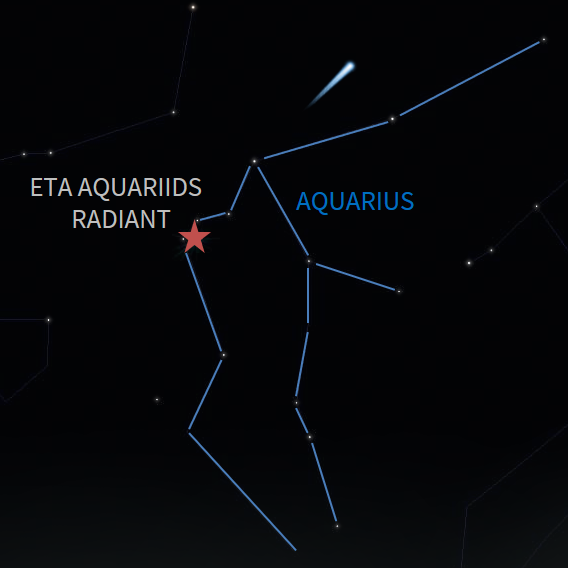 Active: April 19 –May 28
Active: April 19 –May 28
Peak Night: May 5th/6th
When can it be observed?: From 3:00 a.m. – 4:24 a.m.
Expected dark sky rate: 50 meteors per hour.
Moon phase: 63% waxing gibbous (This meteor shower is better for observers in the southern hemisphere, but we can still catch some here. Usually around half as many as the ideal peak.)
FAIR VIEWING CONDITIONS
Eta Aquariids are particles shed by comet 1P/Halley. They hit our atmosphere at 41 miles (66 kilometers) per second.
South Delta Aquariids
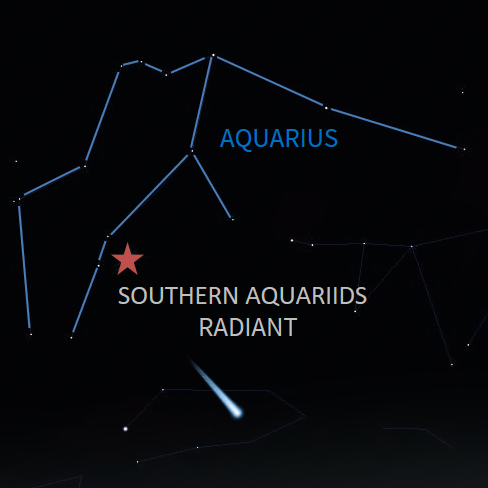 Active: July 12 – August 23
Active: July 12 – August 23
Peak Night: July 30th/31st
When can it be observed?: From 10:00 p.m. – 4:28 a.m.
Expected dark sky rate: 25 meteors per hour.
Moon phase: 34% waxing crescent (While the waxing cresent Moon sets early, this meteor shower will only have fair viewing conditions. As indicated by the name, this shower is more prominent in southern latitudes, with only a fraction of meteors visible in Southern California.)
FAIR VIEWING CONDITIONS
South Delta Aquariid meteors may be produced by particles shed by a sun-grazing comet. They strike our atmosphere at 25 miles (41 kilometers) per second. The radiant of the shower is in the constellation Aquarius the Water Carrier, found in the southern sky after midnight.
Perseids
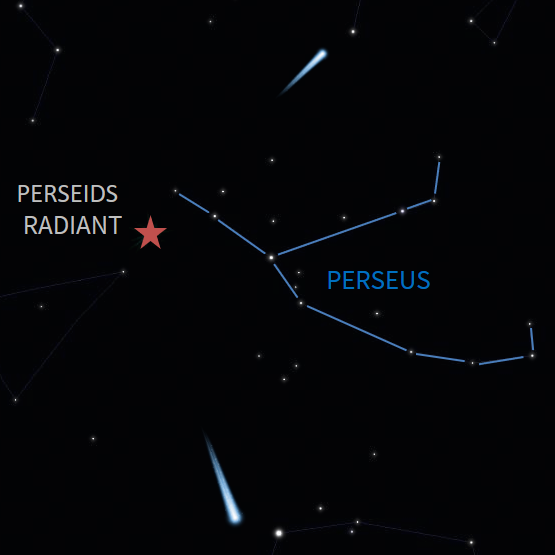 Active: July 17 – August 24
Active: July 17 – August 24
Peak Night: August 11th/12th
When can it be observed?: From 10:00 p.m. – 4:40 a.m.
Expected dark sky rate: 100 meteors per hour.
Moon phase: 92% waning gibbous (The nearly full Moon will disrupt peak viewing of the Perseid meteor shower this year. )
POOR VIEWING CONDITIONS
Perseid meteors are produced by particles shed by comet 109P/Swift-Tuttle. They hit our atmosphere at 37 miles (59 kilometers) per second.
Orionids
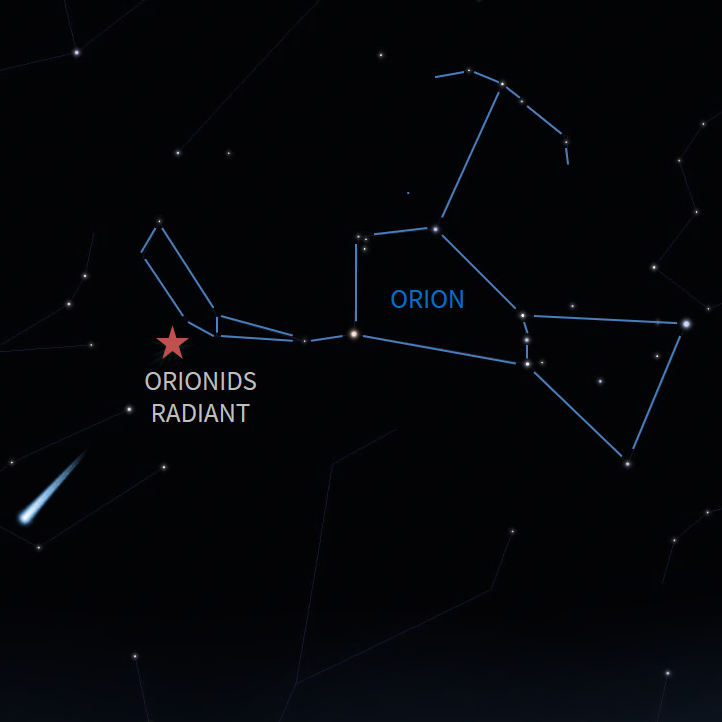 Active: October 2 – November 7
Active: October 2 – November 7
Peak Night: October 20th/21st
When can it be observed?: From 11:00 p.m. – 5:39 a.m.
Expected dark sky rate: 20 meteors per hour.
Moon phase: 0% new moon (While the number of meteors per hour is modest, the new moon will allow dark skies for excellent viewing.)
EXCELLENT VIEWING CONDITIONS
Orionids are particles shed by comet 1P/Halley, and they hit our atmosphere at 41 miles (66 kilometers) per second. The meteors appear to stream from the imaginary upraised club of the constellation Orion the Hunter.
Leonids
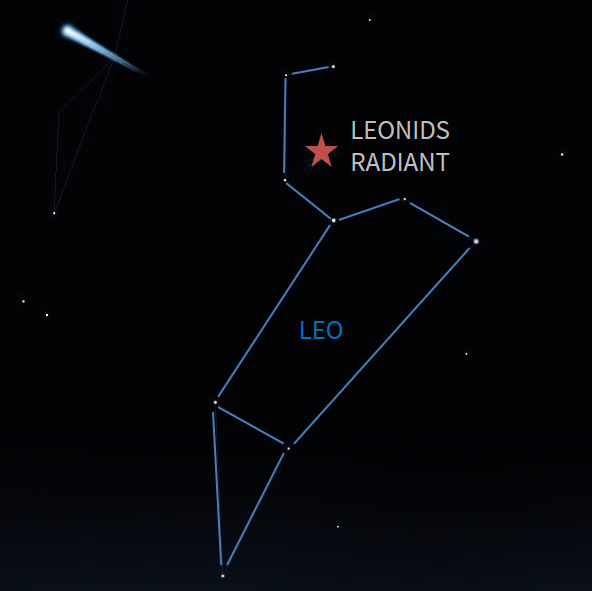 Active: November 6 – 30
Active: November 6 – 30
Peak Night: November 16th/17th
When can it be observed?: From Midnight (12:00 a.m.) – 5:01 a.m.
Expected dark sky rate: 10 meteors per hour.
Moon phase: 10% waning crescent ( There are three prime viewing hours for this meteor shower.)
FAIR VIEWING CONDITIONS
Leonid meteors are particles shed by comet 55P/Tempel-Tuttle. They hit our atmosphere at a rapid 44 miles (71 kilometers) per second. Leonid meteors appear to stream from the “sickle” of the constellation Leo the Lion.
Geminids
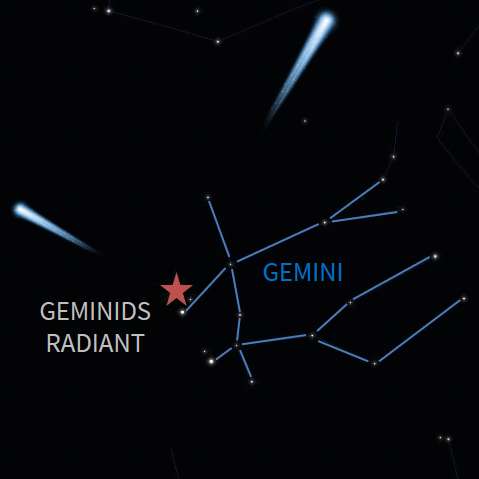 Active: December 4 – 20
Active: December 4 – 20
Peak Night: December 13th/14th
When can it be observed?: From 7:00 p.m. – 5:21 a.m.
Expected dark sky rate: 150 meteors per hour.
Moon phase: 31% waning crescent (Viewing conditions will be good until the moon rises around 1am. After that, the waning crescent may overpower the fainter meteors.)
FAIR VIEWING CONDITIONS
Geminids are particles shed by asteroid 3200 Phaeton, likely a “rock comet.” The particles hit our atmosphere at 22 miles (35 kilometers) per second. The shower’s radiant is close to the bright star Castor in the constellation Gemini the Twins.


Meteor Showers for 2024
Quadrantids
 Active: December 28 – January 12
Active: December 28 – January 12
Peak Night: January 3rd/4th
When can it be observed?: From 2:00 a.m. – 5:29 a.m.
Expected dark sky rate: 80 meteors per hour.
Moon phase: 46% waning crescent ( The Moon will be just past last quarter and will rise during peak hours of the shower and may disrupt the view.)
FAIR VIEWING CONDITIONS
Quadrantids likely are particles from the extinct comet 2003 EH1. They hit our atmosphere with a velocity of 25 miles (41 kilometers) per second. The meteors stream from a radiant located in the northern part of Boötes the Herdsman, between the main figure of Boötes and the handle of the Big Dipper, the site of an obsolete constellation, Quadrans Muralis the Mural Quadrant.
Lyrids
 Active: April 14 – April 30
Active: April 14 – April 30
Peak Night: April 21st/22nd
When can it be observed?: From 10:00 p.m. – 4:43 a.m.
Expected dark sky rate: 18 meteors per hour.
Moon phase: 99% Waxing Gibbous (The full Moon rises with the sunset and will disrupt viewing the entire night.)
POOR VIEWING CONDITIONS
Lyrid meteors are particles shed by the comet C/1861 G (Thatcher). They hit our atmosphere at 27 miles (43 kilometers) per second. The radiant of the Lyrids is close to the brilliant star Vega in Lyra the Lyre, at the zenith (the point directly overhead) when dawn starts.
Eta Aquariids
 Active: April 19 –May 28
Active: April 19 –May 28
Peak Night: May 5th/6th
When can it be observed?: From 1:30 a.m. – 4:24 a.m.
Expected dark sky rate: 30-50 meteors per hour.
Moon phase: 7% waxing crescent ( The Moon will set before the Sun and will not rise until around 4:30am as a crescent. It will not disrupt meteor observations.)
GOOD VIEWING CONDITIONS
Eta Aquariids are particles shed by comet 1P/Halley. They hit our atmosphere at 41 miles (66 kilometers) per second.
South Delta Aquariids
 Active: July 12 – August 23
Active: July 12 – August 23
Peak Night: July 30th/31st
When can it be observed?: From 9:00 p.m. – 4:28 a.m.
Expected dark sky rate: 25 meteors per hour.
Moon phase: 13% waning crescent ( The waning crescent Moon will not rise until around 2:30am and will not greatly interfere with meteor observations.)
GOOD VIEWING CONDITIONS
South Delta Aquariid meteors may be produced by particles shed by a sun-grazing comet. They strike our atmosphere at 25 miles (41 kilometers) per second. The radiant of the shower is in the constellation Aquarius the Water Carrier, found in the southern sky after midnight.
Perseids
 Active: July 17 – August 24
Active: July 17 – August 24
Peak Night: August 11th/12th
When can it be observed?: From 11:00 p.m. – 4:40 a.m.
Expected dark sky rate: 100 meteors per hour.
Moon phase: 47% waxing crescent ( The waxing crescent Moon will set by midnight and will not disrupt meteor observations after that.)
GOOD VIEWING CONDITIONS
Perseid meteors are produced by particles shed by comet 109P/Swift-Tuttle. They hit our atmosphere at 37 miles (59 kilometers) per second.
Orionids
 Active: October 2 – November 7
Active: October 2 – November 7
Peak Night: October 20th/21st
When can it be observed?: From 10:00 p.m. – 5:39 a.m.
Expected dark sky rate: 20 meteors per hour.
Moon phase: 70% waning gibbous ( The radiant point of the shower is next to the waning gibbous Moon. This will greatly reduce the number of meteors that can be observed.)
POOR VIEWING CONDITIONS
Orionids are particles shed by comet 1P/Halley, and they hit our atmosphere at 41 miles (66 kilometers) per second. The meteors appear to stream from the imaginary upraised club of the constellation Orion the Hunter.
Leonids
 Active: November 6 – 30
Active: November 6 – 30
Peak Night: November 16th/17th
When can it be observed?: From Midnight (12:00 a.m.) – 5:01 a.m.
Expected dark sky rate: 5-20 meteors per hour.
Moon phase: 96% waxing gibbous ( The nearly full Moon will be up all night and disrupt meteor observations. The number of observations per hour is more likely to be in the single digits.)
POOR VIEWING CONDITIONS
Leonid meteors are particles shed by comet 55P/Tempel-Tuttle. They hit our atmosphere at a rapid 44 miles (71 kilometers) per second. Leonid meteors appear to stream from the “sickle” of the constellation Leo the Lion.
Geminids
 Active: December 4 – 20
Active: December 4 – 20
Peak Night: December 13th/14th
When can it be observed?: From 8:00 p.m. – 5:21 a.m.
Expected dark sky rate: 120 meteors per hour.
Moon phase: 98% waxing gibbous ( The nearly full Moon will be up all night and disrupt meteor observations. With the full Moon, peak meteor count may be as low as 20 per hour.)
POOR VIEWING CONDITIONS
Geminids are particles shed by asteroid 3200 Phaeton, likely a “rock comet.” The particles hit our atmosphere at 22 miles (35 kilometers) per second. The shower’s radiant is close to the bright star Castor in the constellation Gemini the Twins.


Meteor Showers for 2022
Quadrantids

Active: December 28 – January 12
Peak Night: January 3/4
When can it be observed?: From 11:00 p.m. until dawn (5:30 a.m.)
Approximate peak hour: 4:30-5:30 a.m.
Expected dark sky rate: 12 meteors per hour. The brief—but much stronger—peak of the shower, expected in the Eastern Hemisphere, will be over before darkness falls in North America. The moon, however, will not interfere with observations.
Good viewing conditions
Quadrantids likely are particles from the extinct comet 2003 EH1. They hit our atmosphere with a velocity of 25 miles (41 kilometers) per second. The meteors stream from a radiant located in the northern part of Boötes the Herdsman, between the main figure of Boötes and the handle of the Big Dipper, the site of an obsolete constellation, Quadrans Muralis the Mural Quadrant.
Notes: No moon present.
Lyrids

Active: April 16 – April 26
Peak Night: April 21/22
When can it be observed?: 10:00 p.m. to 4:44 a.m. (dawn).
Approximate peak hour: 3:44-4:44 a.m.
Expected dark sky rate: 18 meteors per hour. The last quarter moon, present after it rises at 1:28 a.m., however, will reduce the observable number of meteors.
Fair viewing conditions
Lyrid meteors are particles shed by the comet C/1861 G (Thatcher). They hit our atmosphere at 27 miles (43 kilometers) per second. The radiant of the Lyrids is close to the brilliant star Vega in Lyra the Lyre, at the zenith (the point directly overhead) when dawn starts.
Notes: moderately bright moonlight will interfere after 1:28 a.m.
Eta Aquariids

Active: April 19 – May 28
Peak Night: May 4/5
When can it be observed?: 3:00 a.m. until dawn ( 4:25 a.m.)
Approximate peak hour: 3:25-4:25 a.m.
Expected dark sky rate: 18 meteors per hour.
Good viewing conditions
Eta Aquariids are particles shed by comet 1P/Halley. They hit our atmosphere at 41 miles (66 kilometers) per second.
Notes: The absence of moonlight in the early morning is ideal for viewing the peak of the shower.
73P-ids Meteor Storm

Active: May 30/31
Peak Night: May 30/31
When can it be observed?: 8:11 p.m. to 10:45 p.m. The shower may end before midnight.
Approximate peak hour: 9:45 p.m.-10:45p.m.
Expected dark sky rate: 10,000-100,000 meteors per hour(!)
Good viewing conditions
The shower’s radiant is on the east side of Boötes the Herdsman, about 10 degrees north of the brilliant star Arcturus, high in the northeastern sky. 73P-ids are an offshoot of the usually unremarkable Tau Herculid meteor shower. Both showers are produced by comet 73P/Schwassmann-Wachmann 3. The nucleus of comet 73P broke into several pieces during its returns in 1995, 2006, and 2017. In 2022 the Earth is predicted to pass through the fresh swarm of nucleus fragments, and, based on computer simulations performed by several meteor experts, a brief meteor storm of historic levels should be the likely outcome!
About 50 (mostly faint) meteors per hour may be seen as soon as darkness falls, but vast numbers of bright meteors may appear around 10:15 p.m. The shower should be visible across North America.
Notes: The moon is new and will not interfere with this exceedingly rare opportunity to observe a likely meteor storm.
South Delta Aquariids

Active: July 21 – August 23
Peak Night: July 27/28
When can it be observed?: 10:00 p.m. to dawn (4:27 a.m.).
Approximate peak hour: 2:34-3:34 a.m.
Expected dark sky rate: 12 meteors per hour.
Good viewing conditions
South Delta Aquariid meteors may be produced by particles shed by a sun-grazing comet. They strike our atmosphere at 25 miles (41 kilometers) per second. The radiant of the shower is in the constellation Aquarius the Water Carrier, found in the southern sky after midnight.
Notes: Moon sets at 8:27 p.m. and it will not be present to interfere with observing the peak activity of the meteors.
Perseids

Active: July 17 – August 24
Peak Night: August 12/13
When can it be observed?: 10:00 p.m.-4:40 a.m.
Approximate peak hour: 3:40-4:40 a.m.
Expected dark sky rate: 83 meteors per hour. The light of the nearly full moon, however, will vastly reduce the numbers of visible meteors.
Poor viewing conditions
Perseid meteors are produced by particles shed by comet 109P/Swift-Tuttle. They hit our atmosphere at 37 miles (59 kilometers) per second.
Notes: Bright moonlight will interfere all night.
Orionids

Active: October 2 – November 7
Peak Night: October 20/21
When can it be observed?: 11:30 p.m.-5:40 a.m.
Approximate peak hour: 4:40-5:40 a.m.
Expected dark sky rate: 19 meteors per hour. Waning crescent moon should not seriously interfere.
Good viewing conditions
Orionids are particles shed by comet 1P/Halley, and they hit our atmosphere at 41 miles (66 kilometers) per second. The meteors appear to stream from the imaginary upraised club of the constellation Orion the Hunter.
Notes: The presence of the waning crescent moon beginning at 3:10 a.m. should not significantly interfere with observations.
Leonids

Active: November 6 – 30
Peak Night: November 16/17, 17/18
When can it be observed?: 11:30 p.m. until 5:00 a.m.
Approximate peak hour: 4:00-5:00 a.m.
Expected dark sky rate: 18 meteors per hour. Moonlight, present beginning at 12:54 a.m., will offer only sight interference.
Fair viewing conditions
Leonid meteors are particles shed by comet 55P/Tempel-Tuttle. They hit our atmosphere at a rapid 44 miles (71 kilometers) per second. Leonid meteors appear to stream from the “sickle” of the constellation Leo the Lion.
Notes: The position of the waning crescent moon, near the meteor radiant will offer some interference.
Geminids

Active: December 4 – 17
Peak Night: December 13/14
When can it be observed?: 8:00 p.m.-5:22 a.m.
Approximate peak hour: 1:23-2:23 a.m.
Expected dark sky rate: 150 meteors per hour, but rates will be significantly decreased by bright moonlight after 9:54 p.m.
Fair viewing conditions
Geminids are particles shed by asteroid 3200 Phaeton, likely a “rock comet.” The particles hit our atmosphere at 22 miles (35 kilometers) per second. The shower’s radiant is close to the bright star Castor in the constellation Gemini the Twins.
Notes: The Geminids are usually the strongest annual meteor shower. Bright moonlight, beginning at 9:54 p.m., will hide the fainter meteors, and will significantly reduce the numbers of meteors seen.


Meteor Showers for 2021
Quadrantids

Active: December 28 – January 12
Peak Night: January 2/3
When can it be observed?: From 11:00 p.m. until dawn (5:30 a.m.)
Approximate peak hour: 4:30-5:30 a.m.
Expected dark sky rate: 90 meteors per hour. This rate may be cut in half by the presence of bright moonlight.
Fair viewing conditions
Quadrantids likely are particles from the extinct comet 2003 EH1. They hit our atmosphere with a velocity of 25 miles (41 kilometers) per second. The meteors stream from a radiant located in the northern part of Boötes the Herdsman, between the main figure of Boötes and the handle of the Big Dipper, the site of an obsolete constellation, Quadrans Muralis the Mural Quadrant.
Notes: Bright waning gibbous moon present.
Lyrids

Active: April 16 – April 26
Peak Night: April 21/22
When can it be observed?: 10:00 p.m. to 4:44 a.m. (dawn).
Approximate peak hour: 3:44-4:44 a.m.
Expected dark sky rate: 18 meteors per hour.
Good viewing conditions
Lyrid meteors are particles shed by the comet C/1861 G (Thatcher). They hit our atmosphere at 27 miles (43 kilometers) per second. The radiant of the Lyrids is close to the brilliant star Vega in Lyra the Lyre, at the zenith (the point directly overhead) when dawn starts.
Notes: The moon sets at 3:47 a.m., allowing the maximum of the shower to be observed with no significant interference.
Eta Aquariids

Active: April 19 – May 28
Peak Night: May 4/5
When can it be observed?: 3:00 a.m. until dawn ( 4:25 a.m.)
Approximate peak hour: 3:25-4:25 a.m.
Expected dark sky rate: 18 meteors per hour.
Good viewing conditions
Eta Aquariids are particles shed by comet 1P/Halley. They hit our atmosphere at 41 miles (66 kilometers) per second.
Notes: The rising of the waning crescent moon at 3:13 a.m. will have little effect on observing the peak hour of meteors.
South Delta Aquariids

Active: July 21 – August 23
Peak Night: July 27/28
When can it be observed?: 10:00 p.m. to dawn (4:27 a.m.).
Approximate peak hour: 2:34-3:34 a.m.
Expected dark sky rate: 12 meteors per hour. This number will be reduced by bright moonlight.
Fair viewing conditions
South Delta Aquariid meteors may be produced by particles shed by a sun-grazing comet. They strike our atmosphere at 25 miles (41 kilometers) per second. The radiant of the shower is in the constellation Aquarius the Water Carrier, found in the southern sky after midnight.
Notes: Moonlight will significantly interfere with observations.
Perseids

Active: July 17 – August 24
Peak Night: August 11/12
When can it be observed?: 10:00 p.m.-4:40 a.m.
Approximate peak hour: 3:40-4:40 a.m.
Expected dark sky rate: 83 meteors per hour.
Good viewing conditions
Perseid meteors are produced by particles shed by comet 109P/Swift-Tuttle. They hit our atmosphere at 37 miles (59 kilometers) per second.
Notes: The moon sets just as the meteors start to appear, resulting in ideal conditions for viewing the shower at its strongest.
Orionids

Active: October 2 – November 7
Peak Night: October 20/21
When can it be observed?: 11:30 p.m.-5:40 a.m.
Approximate peak hour: 4:40-5:40 a.m.
Expected dark sky rate: 19 meteors per hour, but nearly full moon will prevent all but the brightest meteors from being seen.
Poor viewing conditions
Orionids are particles shed by comet 1P/Halley, and they hit our atmosphere at 41 miles (66 kilometers) per second. The meteors appear to stream from the imaginary upraised club of the constellation Orion the Hunter.
Notes: A nearly full moon will severely interfere with meteor observations.
Leonids

Active: November 6 – 30
Peak Night: November 16/17
When can it be observed?: 11:30 p.m. until 5:00 a.m.
Approximate peak hour: 4:00-5:00 a.m.
Expected dark sky rate: 18 meteors per hour. Bright moonlight will greatly reduce the observed rate.
Poor viewing conditions
Leonid meteors are particles shed by comet 55P/Tempel-Tuttle. They hit our atmosphere at a rapid 44 miles (71 kilometers) per second. Leonid meteors appear to stream from the “sickle” of the constellation Leo the Lion.
Notes: The nearly full moon sets at 4:51 a.m., only minutes before the start of dawn, so its bright light will spoil most of the opportunity to see Leonid meteors this year.
Geminids

Active: December 4 – 17
Peak Night: December 13/14
When can it be observed?: 8:00 p.m.-5:22 a.m.
Approximate peak hour: 1:23-2:23 a.m.
Expected dark sky rate: 150 meteors per hour, but rates will be decreased by bright moonlight until 2:45 a.m.
Fair viewing conditions
Geminids are particles shed by asteroid 3200 Phaeton, likely a “rock comet.” The particles hit our atmosphere at 22 miles (35 kilometers) per second. The shower’s radiant is close to the bright star Castor in the constellation Gemini the Twins.
Notes: The Geminids are usually the strongest annual meteor shower. The moon will offer some interference through the peak hour of the shower, until it sets at 2:45 a.m. Observing conditions then become ideal.
Past Meteor and Meteor Shower Observations
Seeing The Perseid Meteor Shower In Southern California, August 2013
The annual Perseid meteor shower will reach its peak between 6:15 a.m. and 6:45 p.m., P.D.T., on Monday, August 12, 2013.
For more information about meteors:
- American Meteor Society, LTD: The pioneering meteor astronomer, Charles P. Olivier, started the American Meteor Society, LTD., in 1911. The AMS is highly recommended for the beginning meteor observer.
- The International Meteor Organization: Founded in 1988, the International Meteor Organization provides detailed meteor forecast, observing information and meteor shower reports. It conducts extensive worldwide visual, photographic, video, and radio observing programs. The IMO is recommended for advanced meteor observers.


